Japan Foundation Prizes for Global Citizenship Public Roundtable Report 【Part 2】
Fostering Communication Through Art: Case Studies in Global Citizenship Activities
2025.3.13
【Special Feature 085】
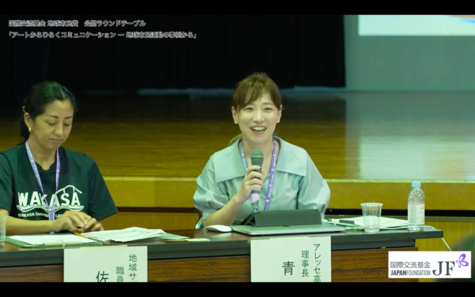
The Japan Foundation Prizes for Global Citizenship are awarded to organizations that make a lasting impact through international cultural exchange in their local community. In June 2024, a public roundtable took place in Okinawa, showcasing the power of art to connect diverse social areas. At the event were representatives from six past award-winning organizations, a moderator, and commentators who engaged in four sessions of sixty minutes each; other participants were welcomed in person and online.
The sessions explored the role of art in four domains: local communities, disaster prevention and preparedness, multicultural coexistence, and education. Each organization shared an overview of their projects and discussed their impact, exchanging ideas with each other in an engaging and dynamic forum. This report captures the key moments of these discussions--Part 1 covers Sessions 1 & 2; Part 2, Sessions 3 & 4. Discover the highlights here and learn even more by viewing the sessions in their entirety on YouTube (link below)!
Date: Sunday, June 30, 2024
Venue: Wakasa Community Center, 3rd Floor Hall, Naha City, Okinawa
Part 1
Session 1: Art × Local Communities
Session 2: Art × Disaster Prevention
Part 2
Session 3: Art × Multicultural Coexistence
Session 4: Art × Education
////////////////////////////////////////////////////////////////////////////////////////
[Presenters](Honorifics omitted; award year in brackets)
Session Key:[LC]Local Communities [DP]Disaster Prevention[MC]Multicultural Coexistence [ED]Education
▶︎Speakers:
Jun Miyagi (Executive Director, Chiiki Support Wakasa) Okinawa [2022] [LC][DP][ED]
Junko Sato (Staff, Chiiki Support Wakasa) Okinawa [2022][MC]
Yuka Aoki (Chair, Alece Takaoka) Toyama [2022][DP][MC][ED]
Hisashi Shimoyama (Representative, The International Theater Festival Okinawa for Young Audiences Executive Committee) Okinawa [2019] [MC][ED]
Hirokazu Nagata (Executive Director, Plus Arts) Hyogo [2014] [LC][DP]
Shizuka Morishita (Director, Tanpopo-no-Ye / Center Director, Good Job! Center Kashiba) Nara [1994][LC][MC]
Rika Uechi (Chief Program Officer, Okinawa Arts Council) Okinawa[LC][DP]
Yukihiro Gushi (Program Officer, Okinawa Arts Council) Okinawa[MC][ED]
Noriko Shimabukuro (Chair, AmerAsian School in Okinawa) Okinawa [2014] [ED]Absent
▶︎Moderator:Tomoko Wakabayashi (Project Coordinator / Specially Appointed Professor, Rikkyo University Graduate School of Social Design Studies)
▶︎Commentator:Taro Tamura (Representative Director, Institute for Human Diversity Japan)
More details of the speakers' profiles here⟩⟩⟩
////////////////////////////////////////////////////////////////////////////////////////
Session 3 *Full-session video available here⟩⟩⟩
Art × Multicultural Coexistence
//////////////////////////////////////////////////
Junko Sato (Chiiki Support Wakasa)[MC]
Yuka Aoki (Alece Takaoka) [DP][MC][ED]
Hisashi Shimoyama (International Children's and Youth Theatre Festival Okinawa)[MC][ED]
Shizuka Morishita (Tanpopo-no-Ye) [LC][MC]
Yukihiro Gushi (Okinawa Arts Council)[MC][ED]
++++++++++++++++++++++++++++++++++++++++++++++++++++++++
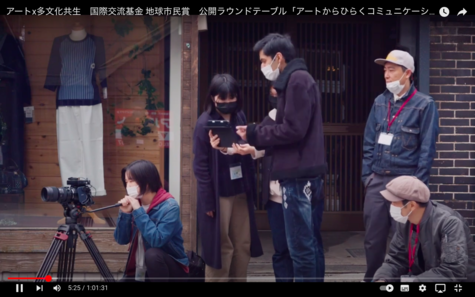
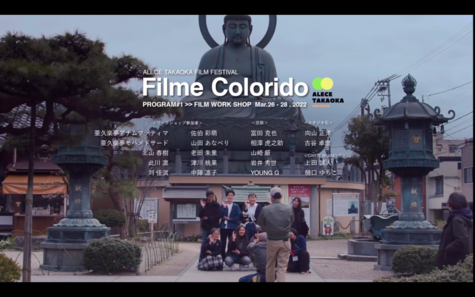
Activity Report⑦
Alece Takaoka (Toyama Prefecture) Yuka Aoki, Chair
Alece Takaoka empowers young people from foreign countries, equipping them to become cultural bridges between Japan and their own countries while playing an active role in their communities.
★This session highlights the workshop on the short film The Takaoka Incident, showcasing its impact and achievements.
Cultivating Multicultural Unity Through Student-Led Film Production
Short-Film Workshop: The Takaoka Incident
In this immersive three-day workshop, ten high school students from diverse backgrounds, including five foreign students, turned their personal experiences into a powerful short film. Recognizing the need to support local youth beyond traditional education, the project embraced filmmaking as a dynamic tool for expression and connection. In the workshop, launched in 2021-22 with the support of the professional film collective Kuzoku, students took on every aspect of production--from acting and cinematography to lighting and sound design. The result was a ten-minute film, screened at a special festival alongside professional works. In Toyama, where discussions around the acceptance of immigrants, of immigration and the education of immigrant children often tend to be negative, this initiative transformed the narrative--inspiring teamwork, creativity, and cross-cultural understanding in a way that was both meaningful and fun.
++++++++++++++++++++++++++++++++++++++++++++++++++++++++
【Roundtable Discussion】
Gushi: Growing up immersed in the world of traditional Ryukyuan dance, I experienced multicultural coexistence in a unique way. While working in schools, I've often been struck by the incredible power of the arts. Seeing how filmmaking can naturally bring diverse communities together was a revelation. Even when things don't go perfectly, genuine effort speaks volumes and earns acceptance. This experience has truly inspired me to explore how culture and the arts can create deeper connections across different backgrounds.
Wakabayashi: When we talk about multicultural coexistence, we often focus on nationality. But as I listened to Mr. Gushi's perspective, I realized that traditional Ryukyuan dance and filmmaking are also important contributors to promoting multicultural coexistence. Multiculturalism is often connected with diversity, but Mr. Tamura, what are your thoughts on this?
Tamura: The true value of art lies in the act of creating something together. After the Great Hanshin Earthquake, I worked as part of a team to produce a multilingual radio program. Through that process, we discovered our different perspectives, insights, and interpretations. Even something as simple as obtaining filming permits made us see things differently. The act of collaborating on a project teaches us valuable lessons about multicultural coexistence.
Aoki: The process itself was definitely important, but what really stood out was completing it as a visible, finished work--a film that people could actually watch. Films, especially, often take on new meanings when shown in different places. For example, during a workshop at a small theater in Toyama, a middle school student from China, who wasn't part of the film project, said, "I feel like the boy without a face." This student struggles with the Japanese language and feels disconnected from school and the community. It was heartbreaking to see just how closely she connected with the character. But that's the power of film--a new setting can create fresh perspectives and emotions. In Toyama, where foreign residents are dispersed and often overlooked by the community, the workshop was a way to bring their stories and talents into the spotlight.
Morishita: Turning imagination into reality and communicating it in a way that keeps pushing discourse forward--this is what makes art so special.
Sato: When children from different countries come together on a project, working creatively as a team and then sharing the experience, multicultural coexistence really comes into focus.
++++++++++++++++++++++++++++++++++++++++++++++++++++++++
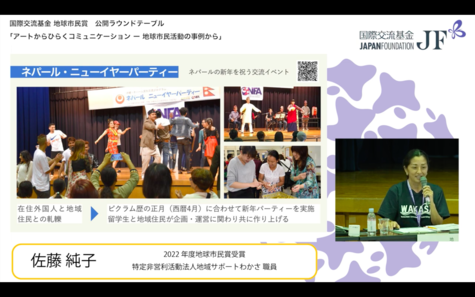
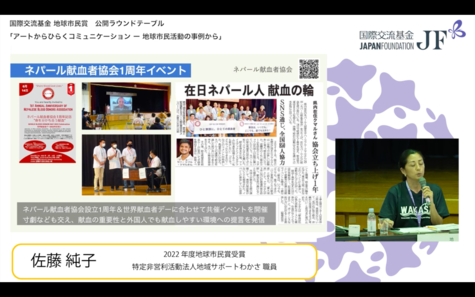
Activity Report⑧
Chiiki Support Wakasa (Okinawa Prefecture) Junko Sato
Located along Naha City's western coastline, Chiiki Support Wakasa is dedicated to creating a vibrant and livable community. By creating strong connections between schools, local residents, and families, this NPO, based at the Naha City Wakasa Community Center and Naha City Wakasa Children's Center, is working to transform the area into a dynamic, thriving neighborhood.
★ In this session, we explore the vibrant initiatives around multicultural coexistence at the Wakasa Community Center.
A Community Hub Where Multicultural Coexistence Flourishes Naturally, Welcoming All
Nepal New Year Party, Multicultural Café, YouTube Club
At the Wakasa Community Center, various teams address the unique challenges that the community faces, with Ms. Sato overseeing the initiatives related to multicultural coexistence. The center is located in an area with several Japanese-language schools, creating a vibrant and diverse community of foreign residents. As an open space accessible to everyone, the community center naturally fosters new connections. Foreign residents, who frequent the lobby, often find themselves contributing to activities like an English conversation circle, connecting with local high school students, leading language classes, or creating apps for the center.
The center's multicultural efforts gained momentum with the launch of the Nepal New Year Party. As the center's initiatives expanded, they attracted more interest, leading to discussions about creating dedicated spaces for people with foreign backgrounds. These efforts have sparked cross-cultural exchanges, connected various groups, circles, and courses within the center, and created a ripple effect that has engaged even the regular visitors to the lobby.
++++++++++++++++++++++++++++++++++++++++++++++++++++++++
【Roundtable Discussion】
Tamura: The term "TABUNKA KYOSEI(multicultural coexistence)" was originally introduced by the Center for Multicultural Information and Assistance (formerly the Foreigners' Earthquake Information Center) after the Great Hanshin Earthquake. Since half of our volunteers were native speakers of foreign languages, we didn't feel right to call ourselves a foreigners' support center. We realized that there was no clear divide between the Japanese and foreign nationals helping each other, and we wanted to move away from a one-sided support dynamic. That's how the term came to be. What's truly special about the Wakasa Community Center is that it's driven by the people who go there. Multiculturalism goes beyond nationality, culture, and age, allowing everyone to take on a leading role--and it continues to grow. The beauty of a community center is that it blurs the lines between host and guest--this fluidity, I believe, is what makes multicultural coexistence so powerful.
Morishita: Sometimes, just providing tea and snacks in a space where everyone can come and go as they please, and even take center stage if they want, creates the perfect environment for relationships to blossom. During the recovery period after the Noto Peninsula earthquake, Yuriko Kuroda, a theater artist based in Kanazawa, started an open salon at the Kanazawa Civic Arts Village. While activities themselves are important, I believe that creating a welcoming space for people to gather is the first essential step.
Wakabayashi:Ms. Sato, in a community center where no one is technically required to do anything in particular, how do you spark communication? Do you step in as a mediator or let the magic happen naturally?
Sato: We don't directly tell people what to do, but we do share information about upcoming events--what is happening where and when. I don't actively seek interactions, but when an opportunity comes my way, no matter how small, I make sure to seize it.
Wakabayashi: Recognizing opportunities and keeping the conversation going--there's a great lesson in that.
++++++++++++++++++++++++++++++++++++++++++++++++++++++++
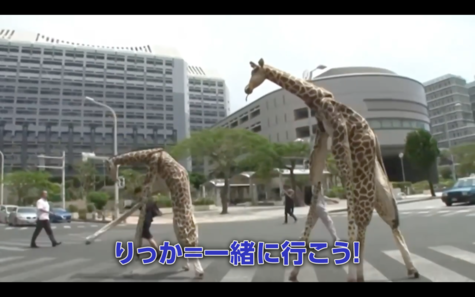
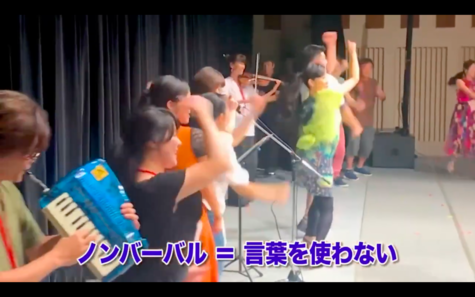
Activity Report⑨
International Children's and Youth Theatre Festival Okinawa Hisashi Shimoyama, Representative
The Ricca Ricca Festa (officially, International Children's and Youth Theatre Festival Okinawa) began in 1994 and has been held for one week every year since 2005, reaching its twenty-second iteration in 2024. This international performing arts festival, with the theme "Theater as Life's Medicine," is dedicated to children, young audiences, and families. Believing that children and youth deserve the very best in the arts, the festival creates transformative experiences that enrich the heart and mind. People of all ages--parents, families, and friends--come together and share in the wonder of live theater. By showcasing performances from around the world, Ricca Ricca Festa fosters cultural exchange, encouraging people to embrace their differences, connect, and take steps toward a more peaceful future.
★This session features an in-depth look at the festival's initiatives and its ongoing impact.
Theater as Life's Medicine--Performances That Inspire You to Embrace Tomorrow
Ricca Ricca Festa
"Ricca" is an Okinawan word meaning "Let's go!"--an invitation filled with energy and excitement. The festival's name is also a play on the Japanese word rikka (marking the start of summer) and the Italian ricca (meaning "rich" or "abundant"). Each year, Ricca Ricca Festa brings artists from around the world to Okinawa, transforming theaters, cultural centers, and schools across Naha into vibrant stages for performances, workshops, symposiums, and networking programs. Audiences can experience a wide variety of productions, from comedy to tragedy, and often attend multiple shows in a single day. One of the festival's outstanding features is its performances specifically for infants and toddlers--something rarely seen in other theater festivals. Many productions are nonverbal, relying on movement and expression rather than language, making them suitable for audiences of all ages, from newborns to adults. By introducing theater at an early age, the festival hopes to nurture a lifelong appreciation of the performing arts, growing both the community of performers and the audiences while fostering emotional richness. The festival is run primarily by young volunteers, most in their twenties, from around the world. The chance to interact with international performers and fellow volunteers makes it a unique cultural exchange, where learning extends far beyond the stage. Through exposure to diverse theatrical expressions and direct interactions with artists, children gain a deeper understanding of global connections, experiencing firsthand how Japan and the world are linked. Aiming to become a hub for children's and youth theater in Asia, Ricca Ricca Festa is built around the concept of "Theater as Life's Medicine." This theme reflects the festival's hope that theater can be a source of healing, inspiration, and connection. While there are many misconceptions about children's and youth theater in Japan, the festival is committed to elevating the genre--enhancing artistic quality, fostering international collaborations in multiple languages, and inspiring creativity through artist-in-residence programs and discussion forums.
++++++++++++++++++++++++++++++++++++++++++++++++++++++++
【Roundtable Discussion】
Wakabayashi:The festival highlights diverse forms of expression--both multilingual and nonverbal--while fostering communication beyond nationality and language. Mr. Gushi, what are your thoughts on this?
Gushi: One of my students had the opportunity to showcase Okinawan theater at the festival, and it was incredible to see how Okinawan arts are subtly but powerfully influencing others. This festival brilliantly taps into Okinawa's unique geographical charm, creating a lively international stage. Plus, the volunteer participation sparks amazing interactions, making it a deeply meaningful event.
Morishita: This is the first I've heard of this event, and I'm blown away by the energy I can feel from the event's theme, "Theater as Life's Medicine," and the photos in the brochure. What kind of quality works do you believe are essential for young people, and how do you go about selecting them?
Shimoyama: In Japan and Korea, suicide is the leading cause of death for young people under 18. When we choose our works, we ask ourselves, Does this encourage people to keep going, to want to live another day? If it doesn't, it isn't fulfilling the purpose of theater. It's not about perfection--it's about whether the audience is moved and departs feeling that humanity is truly beautiful.
Sato: I moved here from Chiba thirteen years ago and have been attending every year since my son was three years old. The festival offers so many performances that are just right for each age group, filled with laughter, tears, and everything in between. Even as an adult, I find them deeply moving. I'm a big fan of this festival!
Shimoyama: While nonverbal and multilingual performances are important, what truly matters is whether the children can connect with them. There are plenty of great performances with dialogue, but if subtitles are provided, people tend to focus on reading them, making it harder for kids to fully engage with the story. Japan, with its rich experience in the Asian context, has a unique role to play. As the challenges facing children in Asia grow, we as theater professionals need to reflect on what we can do for them. That's why I believe nonverbal performances are key.
Wakabayashi: The next Ricca Ricca Festa is just around the corner. I hope you can all come and experience it!
++++++++++++++++++++++++++++++++++++++++++++++++++++++++
Session 4 *Full-session video available here⟩⟩⟩
Art × Education
///////////////////////////
Jun Miyagi (Chiiki Support Wakasa) [LC][DP][ED]
Yuka Aoki (Alece Takaoka) [DP][MC][ED]
Hisashi Shimoyama (International Children's and Youth Theatre Festival Okinawa)[MC][ED]
Yukihiro Gushi (Okinawa Arts Council)[MC][ED]
++++++++++++++++++++++++++++++++++++++++++++++++++++++++
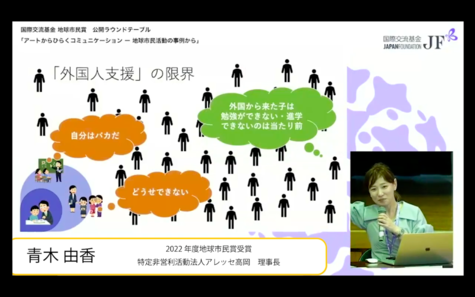
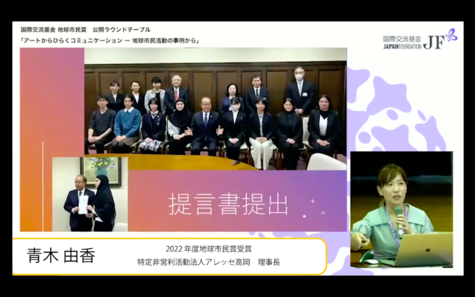
Activity Report⑩
Alece Takaoka (Toyama Prefecture) Yuka Aoki, Chair
Alece Takaoka's mission is to empower foreign youth to become vital bridges between Japan and their own countries, while helping them thrive as active, influential members of their local communities. The organization has two key goals: to nurture the next generation of leaders who will shape the future of their region and to turn diversity into a powerful local asset by building awareness. With this vision, Alece Takaoka has launched several groundbreaking initiatives, including learning-support programs, educational information services, and a transformative citizenship education program that began in 2020. When the pandemic hit, the organization quickly pivoted to offer online learning support, adapting to the challenges of the times. With fifteen years of experience, they've built a strong foundation for change. In areas where foreign populations are scattered, many children remain unnoticed, with their needs unmet. The organization has recognized the limitations of traditional foreigner-support efforts and the need for something more effective. In smaller cities, where minority groups often face exclusion, foreign children--full of untapped potential--are not given the opportunity to shine. The shift must come from the people around them. Tackling the education of foreign children and addressing challenges like Japan's aging population and low birth rate must be viewed as a shared responsibility. Through citizenship education, Alece Takaoka is taking bold steps toward building a more inclusive future.
★ In this session, we report on the Citizenship Education Seminars, the SDGs Art Exhibition, and the Film Festival activities.
Presenting a Vision to the Governor and Aligning Toyama Prefecture's Future with a Shared Vision
Citizenship Education Seminars, SDGs Art Exhibition, Film Festival
These events, which explored the themes of differences, hometown, career design, and SDGs, were part of the Citizenship Education Seminars, SDGs Art Exhibition, and Film Festival. By connecting both foreign and Japanese participants through a variety of activities, they sparked widespread awareness of local issues, earning the prestigious Prize for Global Citizenship. However, while raising awareness is vital, turning this into real-world change presents challenges. To tackle this, eleven foreign young people from Toyama Prefecture conducted a Learning Needs Survey, created actionable proposals, and presented them to the governor. Since then, news reports have shown that the prefecture's education policies seem to reflect their suggestions, signaling that their voices are being heard. This moment feels like a small but important step toward sharing a common vision with Toyama's leadership. One particularly powerful comment came from a Filipino participant: "I grew up thinking it was normal to hide my background. But through this project, I realized how much I had to conceal it as a child, and now I feel overwhelming anger and sadness. It might have been easier not to know, but now that I do, it feels so much harder. I want to change the situation for children who cannot take pride in their heritage."
++++++++++++++++++++++++++++++++++++++++++++++++++++++++
【Roundtable Discussion】
Tamura: To make multicultural community a reality, we need an approach that sparks change across society as a whole. Education is often viewed only as receiving knowledge from others, but citizenship education challenges us to learn together and think as one. This is exactly what is embodied in Alece Takaoka's Citizenship Education Seminars, which earned them the Prize for Global Citizenship. Their approach has spread from Takaoka to the rest of Japan, but we need to create more opportunities like this to keep the movement growing.
Wakabayashi: Education comes in many forms, from citizenship education to traditional schooling, but even the wisdom passed down through generations plays a key role. Let's discover how the Wakasa Community Center is bringing art into social education.
++++++++++++++++++++++++++++++++++++++++++++++++++++++++
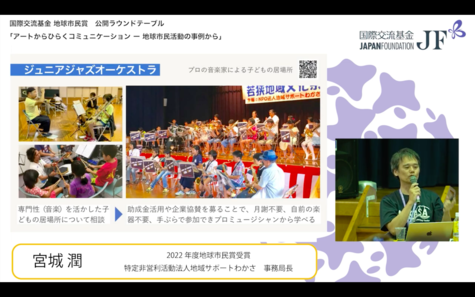
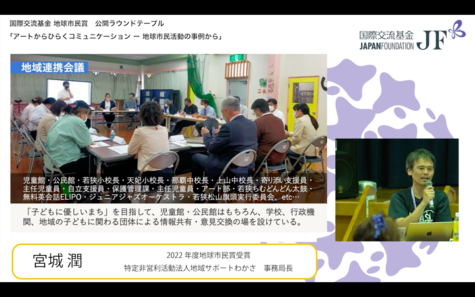
Activity Report⑪
Chiiki Support Wakasa (Okinawa Prefecture) Jun Miyagi
Located along Naha City's western coastline, Chiiki Support Wakasa is dedicated to creating a vibrant and livable community. By creating strong connections between schools, local residents, and families, this NPO, based at the Naha City Wakasa Community Center and Naha City Wakasa Children's Center, is working to transform the area into a dynamic, thriving neighborhood.
★ In this session, we report on collaborative initiatives with the children's center, focusing on a variety of engaging activities and efforts to make Wakasa a child-friendly town.
Varied Activities and the "Children's Safe Space Program" in Partnership with the Children's Center
School education operates like what is often called a "Sparrow School" in Japan, where all students learn at the same time, following a set curriculum. In contrast, social education functions more like a "Medaka School", meaning where the learners take the lead, with no clear distinction between teacher and student. It spans generations, allowing everyone--from children to older adults--to engage in learning, with individuals choosing their own path. The Wakasa Community Center, located in an area with two middle schools and four elementary schools, is the central hub of these activities. Among the initiatives offered are the Wakasa Chimudondon Drums, a children's Eisa team that encourages creativity, the Junior Jazz Orchestra, where children learn from professional musicians without the need to buy instruments or pay fees, and the Children's International Film Festival in Okinawa, in which children participate as jurors, hosts, and technical staff. Other activities include the Umisora Film Screening in Wakasa, ELIPO (free English conversation classes), and the Saturday Morning School, where university students provide learning support while gaining practical experience as interns. Additionally, there are the Brazilian Samba Classes, the Antarctic Class by Antarctic-expedition OBs, the Toyota Science Wonder Box! (interactive lectures by Toyota engineers), the Art Club for middle school students, the Mozambique Songs and Culture Presentation @ Wakasa Elementary, and Disaster Prevention Education Rikka! Yaaru Caravan!, where children learn about safety. Workshops are also offered where children can engage directly with election candidates in online Q&A sessions. In recent initiatives, in partnership with the Wakasa Children's Center, there has been a focus on creating a child-friendly town through experience-based activities. This is not only about providing a sense of belonging but also offering a safe space for children to explore, make choices, and grow. These activities offer experiences that go beyond traditional school education, with the community coming together to observe and share insights in regional collaboration meetings. While school education is often goal-oriented, social education embraces the unexpected lessons that emerge. The objective is to create an environment where children can learn through experience, whether intentionally or incidentally. In this way, social education, much like art, serves as both the means and the end, providing endless opportunities for growth and development.
++++++++++++++++++++++++++++++++++++++++++++++++++++++++
【Roundtable Discussion】
Gushi: Today, I've realized the distinction between school education and social education for the first time. Okinawan performing arts have that same kind of distinction. Even in traditional local arts, there are moments when it's hard to tell who the teacher is. Having worked in schools, I now think that if we had understood social education better during the most challenging times in education, we could have collaborated more effectively. In schools, students can often become too dependent, but in social education, where they interact with adults, it seems to have a positive effect on the children. I've discovered that by collaborating in a different way from that of the school system, we can contribute to education in a more meaningful and effective manner.
Wakabayashi: Even though it may seem like it's aimed at children, it has the potential to shift the way adults view things too.
Shimoyama: The activities at Wakasa Community Center are truly inspiring. We also hope that families--parents, children, and friends--can come together to enjoy performances like "Little Red Riding Hood" or Carmen, and use them to reflect on life. Theater offers a chance to experience life's challenges without being scarred. While it might not be formal education, the festival is still an opportunity for personal growth and development. It would be wonderful to expand this through partnerships with local businesses and shopping districts.
Wakabayashi: To everyone here, do you have any questions about the intersection of education and art or about multicultural coexistence?
Audience Member: In the talk by Ms. Aoki of Alece Takaoka, the term "citizenship education" came up. When thinking about community building, I feel that the quality of family education has been slowly declining, and even though schools teach ethics, there's an overall sense of burnout. There are also situations where adults clash or disagree with each other. Could you share an example of a time when you focused on citizenship or tried to integrate it into your work?
Aoki: It might not be a specific story, but I always encourage people not to walk away just because their opinions aren't accepted. Instead, I suggest creating a space for discussion and setting some ground rules. When people with differing views come together, it's important to make compromises at times, stand firm at other times, but eventually find a solution that everyone can agree on. I believe this process of working together and finding common ground is what true citizenship is all about.
///////////////////////////
【Roundtable Conclusion】
Wakabayashi: This concludes the Art × Education session. Could each of you please give a brief closing remark.
Gushi: I learned so much today and hope to give back--both to children and to society--even in ways that aren't visible. I owe my place at the Okinawa Arts Council to my experience at the University of the Arts. If I were to create my own Prize for Global Citizenship, I'd want to give it to my colleagues--they're that incredible. We host a Cultural Subsidy Consultation on the 20th of every month, so feel free to stop by the Cultural Promotion Association anytime!
Morishita: Experiencing the incredible energy of Okinawa's creative scene has been truly inspiring! It's amazing to think that thirty years have passed since Tanpopo-no-Ye received the Prize for Global Citizenship in 1994. Through the arts and music, we've been expanding our reach across Asia, and now we're more excited than ever to give back--creating opportunities for community engagement and meaningful work. This trip also opened my eyes to how much more there is to learn about international exchange and multicultural connections. I can't wait to take these ideas back to Nara, share them with my team, and turn them into action!
Shimoyama: Ricca Ricca Festa wouldn't be possible without the incredible support of our volunteers, from reception staff to the administrative team. While numbers have dropped since the COVID-19 pandemic, last year we still had around forty university students join us from Taiwan, Hong Kong, and Singapore. Even today, we're running the event alongside students from the University of the Ryukyus and local high schools, working together to build our theater, using both Japanese and English. For us, this hands-on experience is a key part of developing future talent. Japan needs more stories that challenge perspectives--like "Little Red Riding Hood," in which the wolf asks, "Why am I the villain?" I hope people will come together--with their friends, family, or kids--to see these performances and leave with something to talk about, sparking real conversations about life.
Aoki: It was truly inspiring to sit alongside people who are already making things happen--the very things I've only wished for. Today was a day of learning for me, following the lead of incredible role models and thinking, "This is the path forward." Mr. Miyagi talked about viewing school education through the lens of social education, and that really stuck with me. My work focuses on empowering young people with foreign backgrounds to share their voices and succeed, but honestly, I sometimes feel like I shouldn't be the one speaking here. When Japanese isn't your native language, it can feel like a wall that blocks you from joining the conversation. That's why I want to explore how we can create truly inclusive spaces--where communication is equal, whether through nonverbal methods or other ways that foster open, meaningful dialogue.
Sato: Receiving this prestigious award has fueled my drive to do even more. It's truly motivating to see the work of community centers and NPOs recognized. Hearing everyone's stories today has inspired me to take our efforts to the next level.
Miyagi: It was an incredible honor to hold the public follow-up event for the Prize for Global Citizenship at the Wakasa Community Center, and I gained so much from it. I might be a bit of a skeptic, but I believe questioning what we consider "normal" can be really valuable. When it comes to multicultural coexistence and the arts, the assumptions and fixed ideas we take for granted might be wrong. Adopting a questioning perspective can shift how we view the world, and I hope to retain that mindset as we continue building society.
Tamura: Although I couldn't be there in person, I could still sense the event's atmosphere from online. Today's theme, "Fostering Communication Through Art," centered on art as a powerful tool. Art is a gateway to social issues, but how can we use it to break down barriers and reach children with foreign backgrounds, who are harder to connect with? There were plenty of great ideas on the ways art can bridge these gaps. It's not enough to simply nod along as an audience member; we need to actively engage and create initiatives that truly resonate with people.
The idea of opening up spaces, initiatives, and organizations to foster new forms of communication was just as important. Communication can't be one-sided; it must flow both ways. What stuck with me was Mr. Shimoyama's phrase: "Through theater, we want to make people feel like they can face tomorrow." Art has the power to remind us that we are all valuable and that we all have a reason to keep going. The Prize for Global Citizenship initiatives emphasize the importance of thinking about these actions within communities and making sure that everyone feels they have a reason to live. To me, that's what is truly embodied in the concept of the "Global Citizen."
Keywords
Back Issues
- 2025.9.30 The 51st Japan Found…
- 2025.9.30 The Japan Foundation…
- 2025.9.30 Bringing the World C…
- 2025.9.30 The 51st (2024) Japa…
- 2025.9.30 Japan Foundation Pri…
- 2025.9.30 Japan Foundation Pri…
- 2024.5.24 The 50th Japan Found…
- 2024.3. 4 Movie Theaters aroun…
- 2023.4.10 The 49th Japan Found…
- 2023.3.28 JF's Initiatives for…

